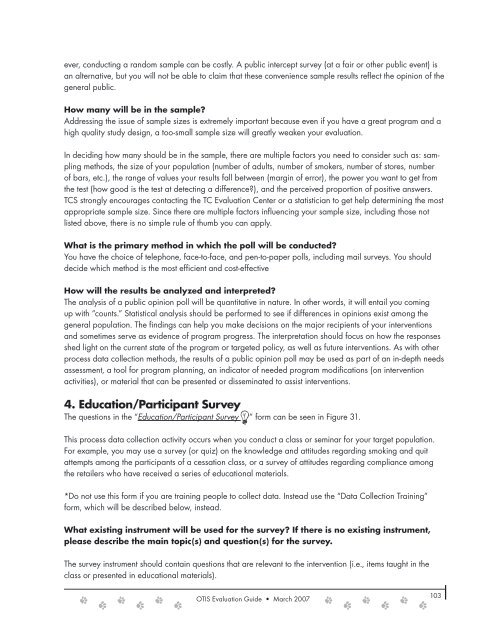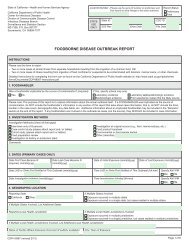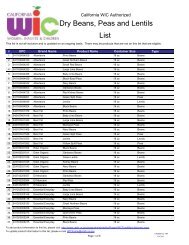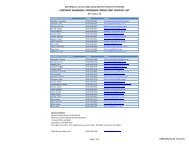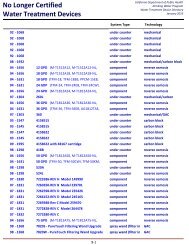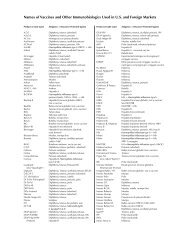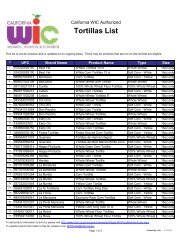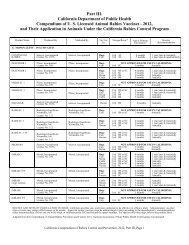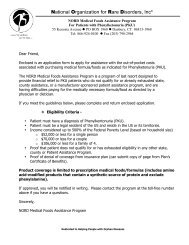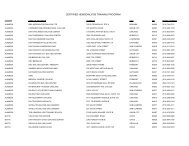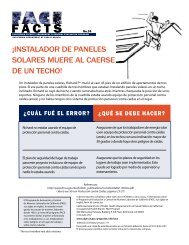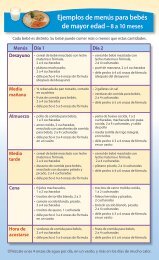OTIS Evaluation Guide (PDF) - California Department of Public Health
OTIS Evaluation Guide (PDF) - California Department of Public Health
OTIS Evaluation Guide (PDF) - California Department of Public Health
Create successful ePaper yourself
Turn your PDF publications into a flip-book with our unique Google optimized e-Paper software.
ever, conducting a random sample can be costly. A public intercept survey (at a fair or other public event) is<br />
an alternative, but you will not be able to claim that these convenience sample results reflect the opinion <strong>of</strong> the<br />
general public.<br />
How many will be in the sample?<br />
Addressing the issue <strong>of</strong> sample sizes is extremely important because even if you have a great program and a<br />
high quality study design, a too-small sample size will greatly weaken your evaluation.<br />
In deciding how many should be in the sample, there are multiple factors you need to consider such as: sampling<br />
methods, the size <strong>of</strong> your population (number <strong>of</strong> adults, number <strong>of</strong> smokers, number <strong>of</strong> stores, number<br />
<strong>of</strong> bars, etc.), the range <strong>of</strong> values your results fall between (margin <strong>of</strong> error), the power you want to get from<br />
the test (how good is the test at detecting a difference?), and the perceived proportion <strong>of</strong> positive answers.<br />
TCS strongly encourages contacting the TC <strong>Evaluation</strong> Center or a statistician to get help determining the most<br />
appropriate sample size. Since there are multiple factors influencing your sample size, including those not<br />
listed above, there is no simple rule <strong>of</strong> thumb you can apply.<br />
What is the primary method in which the poll will be conducted?<br />
You have the choice <strong>of</strong> telephone, face-to-face, and pen-to-paper polls, including mail surveys. You should<br />
decide which method is the most efficient and cost-effective<br />
How will the results be analyzed and interpreted?<br />
The analysis <strong>of</strong> a public opinion poll will be quantitative in nature. In other words, it will entail you coming<br />
up with “counts.” Statistical analysis should be performed to see if differences in opinions exist among the<br />
general population. The findings can help you make decisions on the major recipients <strong>of</strong> your interventions<br />
and sometimes serve as evidence <strong>of</strong> program progress. The interpretation should focus on how the responses<br />
shed light on the current state <strong>of</strong> the program or targeted policy, as well as future interventions. As with other<br />
process data collection methods, the results <strong>of</strong> a public opinion poll may be used as part <strong>of</strong> an in-depth needs<br />
assessment, a tool for program planning, an indicator <strong>of</strong> needed program modifications (on intervention<br />
activities), or material that can be presented or disseminated to assist interventions.<br />
4. Education/Participant Survey<br />
The questions in the “Education/Participant Survey ” form can be seen in Figure 31.<br />
This process data collection activity occurs when you conduct a class or seminar for your target population.<br />
For example, you may use a survey (or quiz) on the knowledge and attitudes regarding smoking and quit<br />
attempts among the participants <strong>of</strong> a cessation class, or a survey <strong>of</strong> attitudes regarding compliance among<br />
the retailers who have received a series <strong>of</strong> educational materials.<br />
*Do not use this form if you are training people to collect data. Instead use the “Data Collection Training”<br />
form, which will be described below, instead.<br />
What existing instrument will be used for the survey? If there is no existing instrument,<br />
please describe the main topic(s) and question(s) for the survey.<br />
The survey instrument should contain questions that are relevant to the intervention (i.e., items taught in the<br />
class or presented in educational materials).<br />
<strong>OTIS</strong> <strong>Evaluation</strong> <strong>Guide</strong> • March 2007<br />
103


